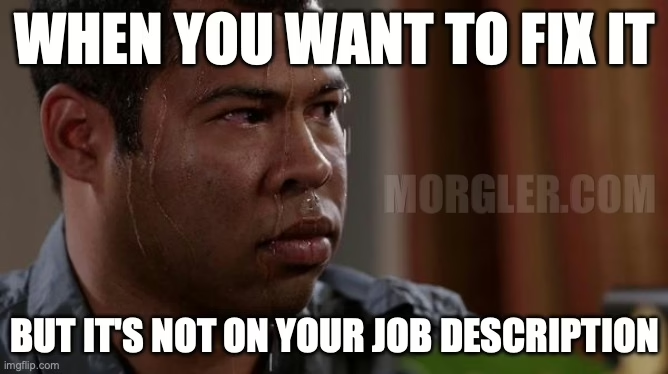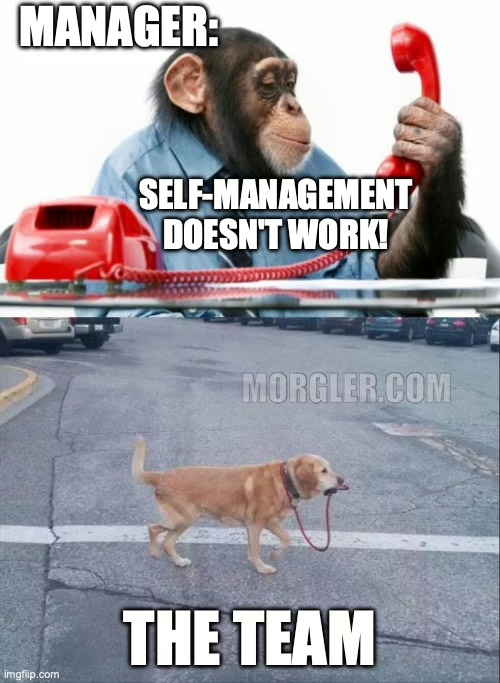Why your team isn’t stepping up—and what you can do about it.
You’ve probably seen it.
You’re working with a team that’s been told: “You are now self-managing!”
Freedom! Autonomy! Accountability!
And then… nothing.
They wait to be told what to do. They stick rigidly to their roles. They don’t speak up. They don’t want to own decisions.
And the manager looks at you and says: “See? Self-management doesn’t work here.”
Cue the ancient chorus of Taylorism:
“Some people just need to be told what to do. They don’t want freedom. They’re not intrinsically motivated. This agile thing isn’t for us.” – 20th Century Manager
But what if that team wasn’t always like this?
What if they had just learned, over time, that trying was futile?

What is Learned Helplessness?
The term “learned helplessness” was coined in the 1960s by psychologists Martin Seligman and Steven Maier. In a nutshell, it describes a state in which people (or animals) learn—through repeated failure or punishment—that their actions don’t matter. So they stop trying, even when escape or change is possible.
In humans, it manifests like this:
- “That’s just how things are here.”
- “We’ve tried that before.”
- “I’m not paid to think.”
- “Why bother? It’ll just get shut down.”
And here’s the truth: it’s not laziness. It’s a trauma response.
A rational adaptation to an environment where initiative has historically been punished, ignored, or overridden.
Learned Helplessness in Agile Transformations
This shows up painfully often in our work as agile coaches.
A company decides to try agile. Leadership is (cautiously) optimistic. They want empowered teams. They give people more freedom.
And then? The team seemingly “proves” them wrong.
They don’t self-organize. They wait passively. They seem to want to be micromanaged.
And so the old worldview is reinforced:
“See? People are lazy. Agility doesn’t work for our kind of people.”
But here’s what’s actually happening:
These people may have tried to step up before. They tried thinking ahead. They took ownership. And they got punished for it—sometimes subtly, sometimes catastrophically.
So they learned: it’s safer to play dumb and stay small.
Agile doesn’t fail because people can’t self-manage. It fails because we don’t give them time and safety to unlearn helplessness.

So What Can We Do?
1. Ask for Sustained Disbelief
When you work with managers, ask them to hold off on judgment.
Learned helplessness can’t be reversed in two sprints.
People need time to believe that the cage door is really open. They won’t run free the moment you unlatch it. Many will stay put—because they’ve learned the wild is dangerous.
2. Rebuild Safety Through Failure Culture
Here’s what effective coaches and leaders do:
- Celebrate mistakes.
In workshops, we often say: “You have to make two mistakes per day. If not, you failed!”Every time someone slips up, we cheer: “Woohoo, mistake!” It sounds silly. But it works. The fear dissolves. People relax. And soon, they laugh and say, “Only one more mistake to go today!” (I learned this particular technique from the renowned leadership coaches at Silicon Valley Alliances) - Praise failed initiatives.
When someone tries to do something bold and it goes wrong, that’s the moment to applaud them. “Yes, it failed. But you took initiative. You stepped up. That’s what we need.” - Leaders must model it.
If a leader says, “I made the wrong call. Here’s what I learned,”—that’s gold. It humanizes them. It builds trust. And it proves that failure is not fatal.
3. Create Small Wins
Research shows that the antidote to learned helplessness is restoring agency.
Start small:
- Let the team decide how to solve a task.
- Let them shape part of the backlog.
- Let them define one metric they care about.
Each small win rewires the belief: “Maybe our actions do make a difference.”
Final Thought: They Weren’t Born This Way
The quiet team. The passive team. The “lazy” team.
They weren’t born that way. They learned to be that way—through years of subtle punishment.
As coaches, we’re not just changing processes. We’re rewiring hope.
And it starts with creating a space where people feel safe to try again.
Want a gripping story to explain learned helplessness to your clients? In the upcoming “Agile Stories” bundle, I’ll include the powerful experiment that started it all—without the dog trauma, but with all the insights.
